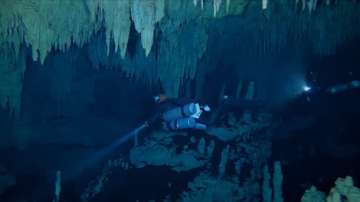A group of underwater explorers has managed to connect two of the largest flooded cavern systems on Earth revealing the largest flooded cave in the world.
The Great Maya Aquifer Project (GAM) team found the connection between Sac Actun and Dos Ojos in Tulum, Quintana Roo after 10 months of intense exploration.
According to the rules of caving, when two cave systems are connected, the largest cave absorbs the smallest, so the name of the latter disappears. Thus, the Sac Actun System is now considered the largest in the world, with a length of 347 kilometers of flooded cave.
Until a couple of days ago, the Ox Bel Ha System, located south of Tulum, was the longest with 270 kilometers; the Sac Actun System, located northeast of Tulum, had 263 km and was in second place in extension. The third on the list was the Kook Baal System with 93 km and the fourth was the Dos Ojos System, which had 83 km; the latter is now added to the Sac Actun System, as a result of this intensive exploration, GAM website said.
Now the goal is to connect Sac Actun with the other three underwater cave systems, which are very close to each other, located in the municipality of Tulum, the researchers announced on the website.
In addition, and as a result of this search, the GAM exploration group has registered another important system with a length of 18 km so far called "The mother of all the cenotes" whose maximum depth is 20 meters and is located north of Sac Actun.
Cenotes were of religious significance to Maya people who sacrificed humans, animals, and objects in them as a means of worship to their Gods. Previous excavations carried out in the cenotes of Yucatan peninsula have recovered a large of objects including gold, pottery, incense and human remains.
The mother of all the cenotes, is for the moment an individual system but the GAM team is very close to connecting it with the Sac Actun System.
These hundreds of kilometers of underground passages have become true tunnels of time and protect, among other things, the remote and recent history of Quintana Roo.
"This immense cave represents the most important archaeological site in the world, as it has more than a hundred archaeological contexts, among which are evidence of the first settlers of America, as well as extinct fauna and, of course, the Mayan culture," says Guillermo de Anda, researcher at the National Institute of Anthropology and History and director of the Great Maya Aquifer.
This finding is also very valuable, because it gives rise to and supports a great biodiversity that depends on this enormous system and represents a large reserve of fresh water that has given life to this region of the Yucatan Peninsula, from time immemorial to the present day.
The Yucatan peninsula is studded with monumental relics of the Maya people, whose cities drew upon an extensive network of sinkholes linked to subterranean waters known as cenotes.
Some cenotes acquired particular religious significance to the Maya, whose descendants continue to inhabit the region.
Latest World News

